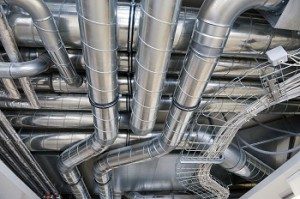Is Poor Ventilation Threatening Your Productivity?
 With increased environmental and health concerns, indoor air quality has become a critical focus across all industries. Manufacturers and food processors— especially those dealing with chemicals, running heavy or high-tech machinery, or producing ready-to-eat foods— must do whatever is necessary to keep the air in their facilities clean. Doing so will ensure better health amongst your workforce, meaning more productivity and fewer sick days. It also ensures the sanitation of plants and products. While these health and safety issues are paramount, many facilities still do not have the ventilation systems needed to provide clean, fresh air.
With increased environmental and health concerns, indoor air quality has become a critical focus across all industries. Manufacturers and food processors— especially those dealing with chemicals, running heavy or high-tech machinery, or producing ready-to-eat foods— must do whatever is necessary to keep the air in their facilities clean. Doing so will ensure better health amongst your workforce, meaning more productivity and fewer sick days. It also ensures the sanitation of plants and products. While these health and safety issues are paramount, many facilities still do not have the ventilation systems needed to provide clean, fresh air.
Employee Health and Productivity
Sick Building Syndrome (SBS) is a term often used when a building’s occupants suffer from health problems that appear to be associated to time spent in the building, and no other cause can be found.
The causes of SBS can usually be attributed to flaws in the heating, ventilation, and air conditioning (HVAC) systems. Other causes include contaminants produced by the outgassing of certain materials, volatile organic compounds (VOCs), improper ventilation of machine exhaust (ozone), use of light industrial chemicals, and a lack of adequate fresh-air intake and filtration.
The symptoms of SBS may include:
- headaches
- fatigue
- nausea
- dizziness
- aches and pains
- poor concentration
- tightness in the chest or shortness of breath
- nasal congestion and irritation
- eye and throat irritation
- skin irritation
People who work in the same building may experience different symptoms, and oftentimes, symptoms will improve or disappear completely after leaving the building and return upon re-entry. Poor ventilation can also lead to extreme temperatures and heat exhaustion.
It’s easy to see how Sick Building Syndrome could hamper employee productivity and increase health costs. Research conducted by the World Green Building Council identified numerous studies which found that poor air quality consistently lowered output by up to 10 percent. Similarly, lab-based tests suggest that high levels of CO2 can have a significant impact on decision-making skills. Results showed 11 to 23 percent increases in poor judgement at 1000 parts per million (ppm) compared to 600ppm, despite 1000ppm being widely accepted as safe.
Other research cited by WGBC links improved ventilation with up to 11 percent increases in productivity and 35 percent decreases in short-term sick leave. Tests demonstrate that the optimum ventilation rate is between 20 and 30 liters/second, which is much higher than the minimum standards in the U.S., which are between 8 and 10 l/s.
Detailed analysis by Carnegie Mellon found that natural ventilation or mixed-mode air conditioning could achieve 0.8 to 1.3 percent health cost savings, 3 to 18 percent productivity gains, and 47 to 79 percent in HVAC energy savings, for an average return on investment of 120 percent. A similar study estimated the value of improved ventilation to be $400 per employee per year.
Food Processing Sanitation
Older plants (and many newer ones) often use exhaust fans to help expel fumes and other pollutants. But, exhaust without adequate intake creates negative air pressure within the building. In this situation, any time a door or window is opened air is sucked in, bringing water, dust, bacteria, chemicals, insects, mold spores, odors and other contaminants along with it. Food processors working in negative air pressure have no control over what the indoor air contains, because unfiltered air not only streams in through open doors and windows, but also any cracks or other openings in the plant’s envelope. This makes cleaning and sanitation of the plant, equipment, piping and racking practically impossible. A negative air pressure space may also contaminate product, which can have catastrophic effects on production, especially where ready-to-eat food products are concerned.
By creating positive-pressure, highly filtered air zones within a processing plant, a well-designed HVAC system can protect the facility and the product from contamination at every phase of the process. In a positive pressure situation, whenever a door is opened a person would feel air escaping the building. This will help dust collection systems work more efficiently, aiding in cleaning and sanitation efforts.
To maintain the recommended positive pressure condition (10 percent above the HVAC system’s exhaust capacity), the integration of outside air is essential. The outside air should of course be filtered, though the degree of filtration depends on the product being processed. The proper balance of intake and exhaust will generate air turnover, which removes steam, odors, and other airborne contaminants. For some facilities, six air turns per hour is enough, whereas ready-to-eat food processing plants often run 20 to 25 air turns per hour. This kind of HVAC system must be designed by an experienced contractor to suit the facility and the process.
Between ensuring the health of your employees and protecting your products from contamination, air ventilation and conditioning can save your business a great deal of money.
Storee Construction can provide your plant with calculated industrial ventilation and clean indoor air through with a well-designed and fine-tuned HVAC system. It’s our mission to help Springfield, MO manufacturers and food processors thrive in modern, energy efficient facilities.
Contact us to find out more. Call 888-736-2032.

